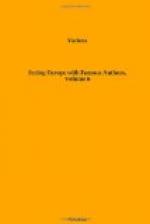The church is in the shape of a cross; and at the end of each of the transepts, is a rich altar, with statuary, in the style of art usual about a century ago. The pews—made of dark mahogany or walnut tree, much after the English fashion, but lower and more tasteful—are placed on each side of the nave, or entering; with ample space between them. They are exclusively appropriated to the tenants of the monastery. At the end of the nave, you look to the left, opposite—and observe, placed in a recess—a pulpit, which, from top to bottom, is completely covered with gold. And yet, there is nothing gaudy or tasteless, or glaringly obtrusive, in this extraordinary clerical rostrum. The whole is in the most perfect taste; and perhaps more judgment was required to manage such an ornament, or appendage—consistently with the splendid style of decoration exacted by the founder, for it was expressly the Prelate Dietmayr’s wish that it should be so adorned,—than may on first consideration be supposed. In fact, the whole church is in a blaze of gold; and I was told that the gilding alone cost upward of ninety thousand florins. Upon the whole, I understood that the church of this monastery was considered as the most beautiful in Austria; and I can easily believe it to be so.
THROUGH THE TYROL[23]
BY WILLIAM CULLEN BRYANT
I left this most pleasing of the Italian cities (Venice), and took the road for the Tyrol. We passed through a level fertile country, formerly the territory of Venice, watered by the Piave, which ran blood in one of Bonaparte’s battles. At evening we arrived at Ceneda, where our Italian poet Da Ponte[24] was born, situated just at the base of the Alps, the rocky peaks and irregular spires of which, beautifully green with the showery season, rose in the background. Ceneda seems to have something of German cleanliness about it, and the floors of a very comfortable inn at which we stopt were of wood, the first we had seen in Italy, tho’ common throughout Tyrol and the rest of Germany. A troop of barelegged boys, just broke loose from school, whooping and swinging their books and slates in the air, passed under my window.
On leaving Ceneda, we entered a pass in the mountains, the gorge of which was occupied by the ancient town of Serravalle, resting on arcades, the architecture of which denoted that it was built during the Middle Ages. Near it I remarked an old castle, which formerly commanded the pass, one of the finest ruins of the kind I had ever seen. It had a considerable extent of battlemented wall in perfect preservation, and both that and its circular tower were so luxuriantly loaded with ivy that they seemed almost to have been cut out of the living verdure. As we proceeded we became aware how worthy this region was to be the birthplace of a poet.




